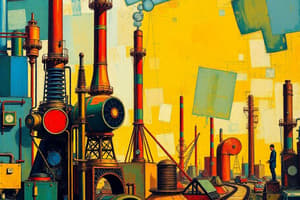Podcast
Questions and Answers
What was the typical working hours for workers in an early nineteenth-century textile factory?
What was the typical working hours for workers in an early nineteenth-century textile factory?
12 hours or more per day
Why were children employed in textile factories during the eighteenth century?
Why were children employed in textile factories during the eighteenth century?
To help support their family
What was the job of 'piecers' in textile factories?
What was the job of 'piecers' in textile factories?
To lean over the spinning machine and repair broken threads while the machine was running
What was the job of 'hurriers' in coalmines?
What was the job of 'hurriers' in coalmines?
What was the job of 'trappers' in coalmines?
What was the job of 'trappers' in coalmines?
What was the occupation of chimney sweeps, and what were the risks associated with it?
What was the occupation of chimney sweeps, and what were the risks associated with it?
When did the Eureka Stockade event take place?
When did the Eureka Stockade event take place?
What was the gathering of 12,000 diggers at Eureka known as?
What was the gathering of 12,000 diggers at Eureka known as?
What was the timeframe of the Industrial Revolution?
What was the timeframe of the Industrial Revolution?
What was the main driver of the Industrial Revolution?
What was the main driver of the Industrial Revolution?
What was the significance of the Spinning Jenny in the Industrial Revolution?
What was the significance of the Spinning Jenny in the Industrial Revolution?
What was the advantage of using coal over wood and charcoal?
What was the advantage of using coal over wood and charcoal?
What was the impact of the Industrial Revolution on agriculture?
What was the impact of the Industrial Revolution on agriculture?
What was the significance of steam power in the Industrial Revolution?
What was the significance of steam power in the Industrial Revolution?
What was the impact of the Industrial Revolution on transportation?
What was the impact of the Industrial Revolution on transportation?
What was the result of the increased use of coal in the smelting process?
What was the result of the increased use of coal in the smelting process?
Flashcards are hidden until you start studying
Study Notes
The Industrial Revolution
- Occurred between 1750 and 1914
- Reshaped the way food, clothing, and other necessities were produced
- Began in Britain in the mid-eighteenth century
- New materials, sources of power, and transport transformed society
Technological Advancements
- Agricultural Revolution:
- Enclosure of open fields
- New farming techniques
- Seed Drill and Rotherham Plough
- Shift to a more business-oriented approach to farming
- Power sources:
- Horses
- Wind
- Water (Water Wheel)
- Steam (Steam Engine)
Textile Industry
- Main driver of the Industrial Revolution
- Production of cotton textiles shifted from cottage industry to factory-based enterprise
- Spinning Jenny (1760s) allowed for yarn to be spun more efficiently
- Cotton mills emerged as specialized factories
Transportation
- Improved methods of transport increased availability of raw materials and distribution of finished products
- Railways and steam engines revolutionized transportation
Conditions in the Workforce
- Early nineteenth-century textile factories were dangerous and unpleasant
- Workers faced:
- Long hours (12 hours or more per day)
- Poor ventilation
- Excessive heat
- Unfenced machines with no safety guards
- High risk of injury
Child Labor
- Common in the eighteenth century for children to work to support their families
- Factory children were known as 'Piecers' or 'Scavengers'
- Jobs included:
- Piecers: repairing broken threads on spinning machines
- Scavengers: collecting cotton waste under running machines
- Hurriers and trappers in coalmines
- Trappers: opening and closing ventilation doors in underground tunnels
- Children as young as four or five were employed as trappers
The Eureka Stockade
- 1854 event
- 12,000 diggers gathered at Eureka
- The Eureka Flag was used
Studying That Suits You
Use AI to generate personalized quizzes and flashcards to suit your learning preferences.




